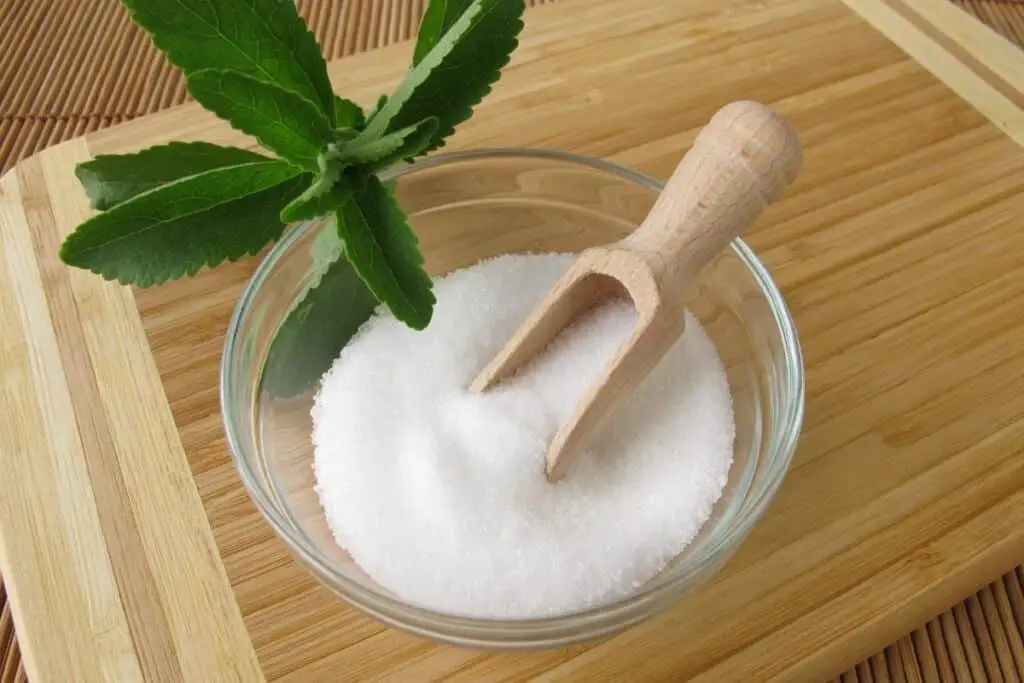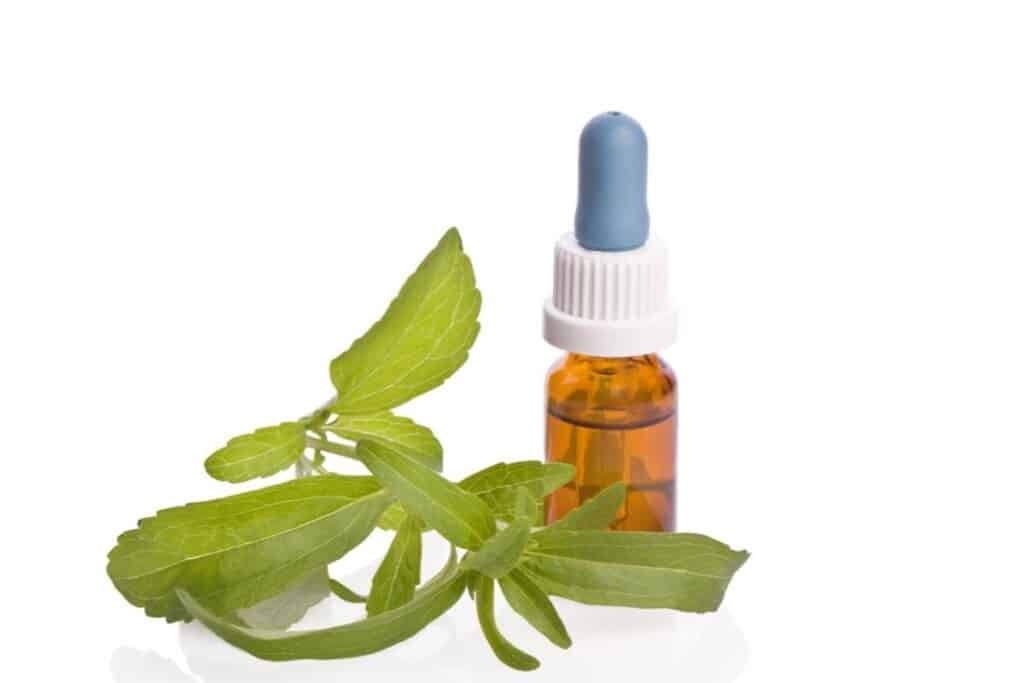If you’re trying to eat healthily, one of the best things you can do is to make simple swaps in your diet like skim milk for whole milk, for example. If you like your sweet treats but are trying to cut down on your sugar for health or lifestyle reasons, then you can substitute sugar and other unhealthy ingredients in baking recipes with other things, such as stevia.
But what is stevia, and how do you use it in baking recipes to substitute sugar? We are ready to answer all your stevia-related questions in this informational article.

What Is Stevia?
Stevia is a sweetener that is frequently substituted for sugar. It usually comes in powder, liquid, or tablet form for ease of use in beverages or recipes. The stevia plant is native to South America, but it is now grown all over the world due to growing popularity and demand.
There are a few good reasons why some people describe stevia as the ideal sugar substitute. Stevia contains next to no calories, so it is marketed as sugar-free and calorie-free or zero-calorie.
It does not raise blood sugar levels as many sugar substitutes do and neither is it an artificial sweetener.
The raw natural substance tastes more than two hundred times sweeter than granulated sugar, so it is a very efficient alternative to unhealthy refined sugar, but figuring out proportions can seem tricky to a beginner. More on that later, though.
How Is Stevia Made?
The stevia plant has been around since at least the 17th century when it was first cultivated by Spanish monks. It is made from the leaves of the stevia rebaudiana plant which grows wild throughout Brazil, Paraguay, Argentina, and Bolivia.
The leaves contain an extract called steviol glycosides which are the main ingredient in stevia. These compounds have a sweetness up to 200 times greater than sucrose (table sugar).
You may also see stevia referred to as “sugar leaf” because of its appearance. However, it’s not technically sugar because it doesn’t contain any carbohydrates or actual sugars. Cooking with stevia instead of refined sugar is one way to seriously decrease the calories in your cake batter.
Commercial stevia is derived from eight glycosides which are the sweet components found in stevia leaves. These stevia extracts are then isolated, purified, dehydrated, dried, and bleached as part of a forty-step process that makes the product fit for purpose as an alternative to sugar.
Can You Bake With Stevia?
Baking with stevia is a great way to reduce sugar intake without sacrificing taste. The only thing is that you will need to calculate how much stevia to use. Using too much stevia can result in your baked product having an unpleasant bitter aftertaste, so it’s important to get it right.
Substituting Sugar For Stevia In Baking
When substituting sugar for stevia in baked goods, remember that 1 teaspoon of stevia will equal about 2 tablespoons of sugar. This means that if you want to replace four tablespoons of sugar specified in a recipe, then two teaspoons will suffice.
Make sure you note the difference between tbsp (tablespoon) and tsp (teaspoon) because we’ve all mixed them up once or twice, right?
If you are using a powdered stevia-based sweetener then for every cup of sugar you would have used, you should use twelve teaspoons of the powder. That’s three spoons for every quarter cup of sugar.
Tablet form is not typically recommended for use in baking recipes because it won’t dissolve until it’s in the oven, so sweetness won’t be even, but you can get liquid stevia which you can use in recipes. For liquid stevia, the ratios get a little complicated though.
It’s recommended that for every 1 cup of sugar, you substitute 2 and a half teaspoons of stevia liquid. For a quarter cup of sugar, you’ll need half a teaspoon and for a half cup of sugar, you’ll need about one and a quarter teaspoons of the stuff. See, we said it was complicated.
Can You Replace Powdered Sugar With Stevia?
You can make your own powdered sugar alternative using stevia and other ingredients. Stevia often comes in a fine powder form, but most people wouldn’t opt to sprinkle this on their cookies or tarts, because straight stevia is an acquired taste.
There are a few recipes that tell you how to make your own stevia-based powdered sugar online. This one from Sweetly Stevia uses corn syrup to make a reduced sugar, sweet, powdery product.
How Much Stevia Equals A Cup Of Sugar?
Stevia comes in two forms that are compatible with baking: powder and liquid. You might think that it would have been best for processors to make it so that you used one cup of powdered stevia to replace one cup of sugar. But, because stevia is super sweet there is no such luck.
To substitute one cup of sugar in a baking recipe, you should use 12 teaspoons of stevia powder suitable for baking. That is equal to 4 tablespoons. It is important not to go by weight for stevia products, as they tend to be much lighter than granulated sugar, and you need much less of them.
So, this will result in a complete baking disaster if you try to match the weight of powdered stevia with the sugar specifications in the recipe.
For liquid stevia products, you should aim to use two and a half teaspoons of the liquid to substitute each cup of sugar.
Banana Bread With Stevia Recipe
Banana bread is a staple recipe of many households and with good reason. They are wonderful for using up slightly overripe bananas that didn’t get eaten before turning just a little too brown and the texture of the fruit makes the cake super moist and lush. The only real downside to banana bread is the sugar content.
Bananas have some natural sugar content of their own, so there’s no such thing as sugar-free banana bread with actual bananas in, but you can replace the sugar you normally add to the recipe with stevia or another alternative.
This recipe from housewifehowtos.com uses one teaspoon of stevia instead of adding sugar or artificial sweeteners, and they also use dried fruit and whole wheat flour to make it an even healthier recipe to tempt your kids with.
Sugar Substitutions In Baking

Liquid Stevia Substitute
Liquid stevia is a natural sugar substitute made from the stevia plant which is many times sweeter than sugar. The liquid is convenient for baking and used in other types of recipes.
Coconut Sugar vs. Stevia
Coconut sugar is fast becoming a popular choice along with stevia as a go-to sugar substitute. Coconut sugar is sometimes referred to as coconut palm sugar or coconut flower nectar. It comes in granulated or liquid forms.
Like stevia, this substitute is naturally occurring, so it’s not an artificial sweetener. But, unlike stevia, coconut sugar is not calorie-free, or sugar-free. It contains around 5 grams of sugar per teaspoon and eighteen calories. This is still less than sugar though, so it is still a good sugar swap to make if you’re not a fan of stevia.
How To Substitute Stevia For Honey
It is easier to substitute liquid stevia for honey in baking recipes because it has a similar consistency. So, if the recipe relied on the honey to make the texture of the finished product perfect then liquid stevia is a pretty close match.
To substitute honey for stevia you should use one teaspoon of liquid stevia per 1/4 cup of honey specified in the recipe. So you would use four teaspoons of stevia per cup of honey. Note that you may need to add moisture to balance the wet and dry ingredients in the recipe because you are using reduced amounts of viscous ingredients.
How To Substitute Stevia For Agave
Agave is a natural sugar substitute made from the nectar of the agave plant. Agave does contain natural sugar, so it also contains calories. Some reports suggest that a portion of agave contains more calories than the equivalent portion of sugar. To use stevia instead of agave in a recipe, you will want to use liquid stevia.
In terms of quantity, it’s a case of trial and error for this one. We recommend trying the recipe with half the specified amount of agave in liquid stevia, but you may need to add more liquid such as water or milk to the mix to get the same consistency.
Once you have the finished product, you’ll be able to note down your observations regarding taste and moisture and if necessary, try again.
Final Thoughts
While stevia is a very popular sugar substitute with many who wish to live in a healthier way, it is worth noting that there are several different stevia products on the market. So, it’s best to check with the specific product you have to see the exact sugar ratio conversions.
With that being said, a general rule for baking with stevia as your sugar substitute is to use 1 teaspoon of powdered stevia for two tablespoons of sugar or four tablespoons of stevia per cup of regular sugar.
For liquid stevia-based sweeteners, you should use 2 and 1/2 teaspoons of stevia per cup of sugar when baking. This should give you the correct amount of sweetness for your favorite sweet treat minus the calories and sugar content.
